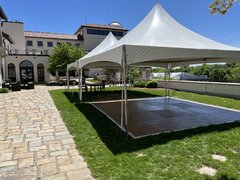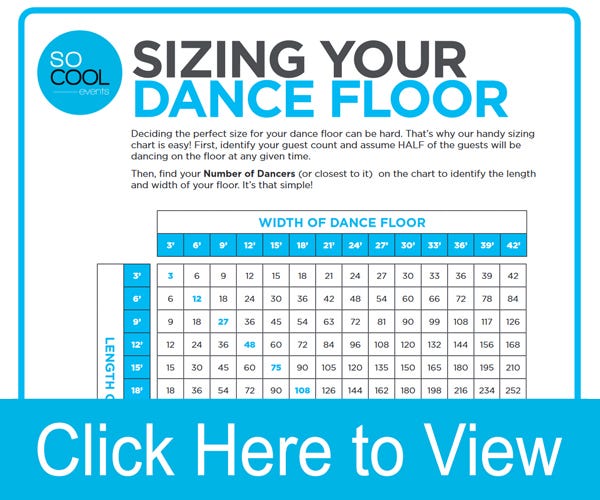Remember the last time you went to a party where the dance floor was so cramped you couldn’t even swing your hips? It’s a frustrating experience, one that can quickly turn a fun night into a chaotic mess. That’s why planning for adequate dance floor space is crucial when hosting any event, from intimate gatherings to large celebrations. But how do you determine the right size for your dance floor? This guide will delve into the factors that influence the perfect dance floor dimensions, ensuring your guests have plenty of room to move and groove.

Image: www.differrentals.com
The Importance of a Well-Sized Dance Floor
A well-sized dance floor is about more than just aesthetics; it’s about ensuring a comfortable and enjoyable experience for your guests. A cramped dance floor can lead to collisions, spilled drinks, and overall frustration, dampening the party mood. Conversely, ample space allows guests to move freely, express themselves through dance, and feel uninhibited, boosting the overall energy and enjoyment level of your event.
Beyond the social aspect, a well-sized dance floor can also impact the success of your event from a practical standpoint. A spacious area allows for better flow during the event, making it easier for guests to navigate between the dance floor, food stations, and seating arrangements. This smooth flow minimizes congestion and potential bottlenecks, ensuring everyone has a comfortable experience.
Factors Influencing Dance Floor Size
The ideal size of a dance floor depends on several factors, including the number of guests, the type of event, and the available space. Here’s a breakdown of these key considerations:
1. Number of Guests
The most significant factor determining dance floor size is the number of guests you anticipate. You need enough space for everyone to dance comfortably without feeling crowded. A general rule of thumb is to allow 3-4 square feet per person for standing room and dancing. For more active dancing styles or larger events, you may want to increase this to 5-6 square feet per person.

Image: socoolevents.com
2. Type of Event
The type of event will influence the desired dance floor size. For intimate gatherings like house parties or small weddings, a smaller dance floor of 100-200 square feet may be sufficient. However, for larger events like corporate parties, weddings with a lot of guests, or events with a specific dance focus, you’ll need a more substantial dance floor, ranging from 300-500 square feet or more.
3. Available Space
The available space will ultimately dictate the size of your dance floor. You’ll need to take into account other elements like seating areas, food and beverage stations, and any other amenities needed for your event. Ideally, you want to dedicate a significant portion of your venue or space to the dance floor while still leaving ample room for other functionalities.
Dance Floor Shape and Layout
The shape of your dance floor can also significantly impact the overall flow and atmosphere of your event. Here are some common dance floor shapes and their potential advantages:
- Square or Rectangular: The most common and practical shape, offering ample space for various dance styles. This shape works well for large gatherings and can be easily proportioned to accommodate the space.
- Round or Oval: Provides a more intimate and visually appealing aesthetic, suitable for smaller events. This shape encourages more mingling and interaction among guests.
- L-Shape: A great option for utilizing corner space and creating a defined area for dancing. It can be particularly effective for events like weddings where the dance floor is connected to the main reception area.
Consider the layout of your venue and the overall flow of your event when selecting a shape. Remember, you want a dance floor that feels inviting and encourages guests to get up and move.
Tips for Maximizing Dance Floor Space
Here are some tips to make the most of your dance floor space and ensure a smooth-flowing event:
- Maximize Natural Light: Natural light is crucial, so strategically position your dance floor to take advantage of windows or outdoor areas. This creates a spacious and inviting atmosphere that feels less confined.
- Choose Versatile Furniture: Instead of large, bulky furniture, opt for pieces that can be easily rearranged or moved when needed to create more dance floor space as the party warms up.
- Plan for a Buffer Zone: Leave a buffer zone around the perimeter of your dance floor to prevent bumping into furniture or walls and allow for better flow.
- Create a Focal Point: A stage or a designated area for the DJ or band can draw guests towards the dance floor and create a vibrant and inviting focal point.
Dance Floor Sizing FAQs
Here are some frequently asked questions about dance floor sizes:
Q: How much space do I need for a 100-person wedding?
A: For a 100-person wedding, aim for a dance floor size of 300-400 square feet, depending on the type of dancing and overall space availability.
Q: What’s the minimum size for a dance floor at a house party?
A: For a smaller house party, a dance floor of 100-150 square feet could be sufficient. However, if you anticipate a lot of dancing, a larger size is always better.
Q: Can I have a dance floor outside?
A: Yes! Outdoor dance floors are fantastic options, especially during warmer months. Ensure the surface is level and stable and consider weatherproofing options, such as a tent or canopy.
Q: What materials are best for a dance floor?
A: Dance floors can be made from various materials, including wood, concrete, and vinyl. Wood is often considered the classic choice for providing a smooth and springy dance surface. Concrete requires a top coat for better traction and can be a cost-effective option. Vinyl dance floors are durable, waterproof, and are a great choice for outdoor events.
How Big Should A Dance Floor Be
Conclusion
Planning for an adequate dance floor size is essential for creating a fun and memorable event. By considering the number of guests, type of event, available space, and dance floor shape, you can ensure your guests have the room they need to move and groove. Remember to take advantage of maximizing natural light, utilizing versatile furniture, and creating a focal point to maximize the dance floor’s potential and create an unforgettable experience for everyone.
Are you planning an event with dancing? We’d love to hear about it! Share your thoughts and questions in the comments below.





